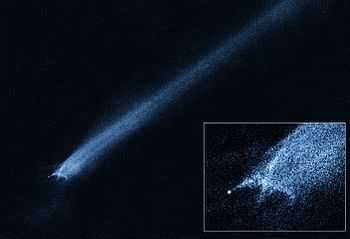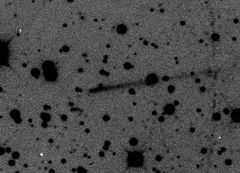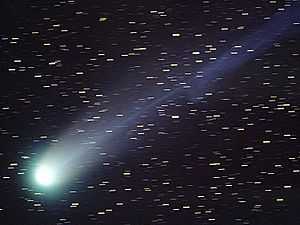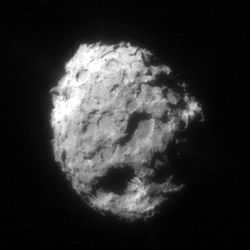P/2010 A2
|
Main-belt comet P/2010 A2 as seen in an 8 min photo with a 24" telescope | |
| Discovery[1] | |
|---|---|
| Discovered by | LINEAR (704) |
| Discovery date | 2010-01-06 |
| Designations | |
|
Comet[2] Asteroid[3] Main-belt comet[4] Small Solar System body | |
| Orbital characteristics[2] | |
| Epoch 2010-Oct-13 | |
| Aphelion | 2.58 AU (Q) |
| Perihelion | 2.01 AU (q) |
| 2.29 AU (a) | |
| Eccentricity | 0.1246 |
| 3.47 yr | |
| 88.9° (M) | |
| Inclination | 5.25° |
| 320° | |
| 133° | |
| Physical characteristics | |
| Dimensions |
220±40 m[5] ~140 m (460 ft)[6] |
| Albedo | unknown |
| ~18-20[1] | |
| 21.3±0.6[7] | |
|
| |
P/2010 A2 (LINEAR) is a small Solar System body that displayed characteristics of both an asteroid and a comet, and thus, was initially given a cometary designation.[1] Since it has the orbit of a main-belt asteroid and showed the tail of a comet, it was listed as a main-belt comet.[2][4] But within a month of discovery, analysis of images by the Hubble telescope suggested that its tail was generated by dust and gravel resulting from a recent head-on collision between asteroids rather than from sublimation of cometary ice.[6] This was the first time a small-body collision had been observed; since then, minor planet 596 Scheila has also been seen to undergo a collision, in late 2010. The position of the nucleus was remarkable for being offset from the axis of the tail and outside of the dust halo, a situation never before seen in a comet.[6] The tail is created by millimeter sized particles being pushed back by solar radiation pressure.[8][9]
Overview

P/2010 A2 was discovered on January 6, 2010 by Lincoln Near-Earth Asteroid Research (LINEAR) using a 1 meter (36") reflecting telescope with a CCD camera.[1] It was LINEAR's 193rd comet discovery.[10][11] It has been observed over a 112 day arc of the 3.5 year orbit.[2] It appears to have come to perihelion (closest approach to the Sun) around the start of December 2009,[2] about a month before it was discovered.
With an aphelion (furthest distance from the Sun) of only 2.6 AU,[2] P/2010 A2 spends all of its time inside of the frostline at 2.7 AU.[12] Beyond the frostline volatile ices are generally more common. Early observations did not detect water vapor or other gases.[6] Within less than a month of its discovery it was doubtful that the tail of P/2010 A2 was generated via active outgassing from sublimation of ices hidden beneath the crust.[4] Early modeling indicated that the asteroid became active in late March 2009, reached maximum activity in early June 2009, and eased activity in early December 2009.[5]
Observations with the Hubble space telescope[13] and the narrow angle camera on board the Rosetta spacecraft[14] indicate that the dust trail seen was probably created by the impact of a small meter size object on the larger asteroid in February or March 2009, although it cannot be ruled out that the asteroid's rotation increased from solar radiation resulting in a loss of mass that formed a comet-like tail.[15]
P/2010 A2 is likely about 150 meters (460 feet) in diameter.[6] Even when it was discovered it was suspected of being less than 500 meters in diameter.[16]
Another object, centaur 60558 Echeclus in 2006, was suspected of outgassing as a result of an undetermined splitting event.[17]
The orbit of P/2010 A2 is consistent with membership in the Flora asteroid family, produced by collisional shattering more than 100 million years ago.[6] The Flora family of asteroids may be the source of the Chicxulub (Cretaceous–Paleogene) impactor, the likely culprit in the extinction of the dinosaurs.[6]
 P/2010 A2 is likely the debris left over from a recent collision between two very small asteroids. |
 Assumed comet nucleus seen to the lower left of debris field |
See also
- P/2013 P5
References
- ↑ 1.0 1.1 1.2 1.3 Marsden, Brian G. (2010-01-07). "MPEC 2010-A32 : COMET P/2010 A2 (LINEAR)". IAU Minor Planet Center. Harvard-Smithsonian Center for Astrophysics. Retrieved 2010-01-14.
- ↑ 2.0 2.1 2.2 2.3 2.4 2.5 "JPL Small-Body Database Browser: P/2010 A2 (LINEAR)" (last observation: 2012-10-14; arc: 2.83 years). Retrieved 2010-02-03.
- ↑ "When is a comet not a comet? Rosetta finds out". ESA News. 13 October 2010. Retrieved 2010-10-15.
- ↑ 4.0 4.1 4.2 Jewitt, David C.. "P/2010 A2 (LINEAR): The 5th Main-Belt Comet". UCLA (Department of Earth and Space Sciences). Retrieved 2010-01-20.
- ↑ 5.0 5.1 Méndez, Javier (23 July 2010). "Comet P/2010 A2, an Activated Asteroid from the Main Asteroid Belt". Isaac Newton Group of Telescopes (ING). Retrieved 2010-07-27.
- ↑ 6.0 6.1 6.2 6.3 6.4 6.5 6.6 Harrington, J. D.; Villard, Ray (2010-02-02). "Suspected Asteroid Collision Leaves Trailing Debris". NASA Release : 10-029. Retrieved 2010-02-03.
- ↑ This absolute asteroidal V magnitude has been calculated using comet/asteroid magnitude analysis software "Comet for Windows" from value of R = 23.0 ± 0.5 taken from IAU Circular No. 9109. The mean V-R color index for asteroids is +0.4 ± 0.1.
- ↑ HST Sees Evidence of Colliding Asteroids, Astronomy Today, Feb.2, 2010
- ↑ Jewitt, David C. "P/2010 A2 (LINEAR): Possible Asteroid Smash". UCLA (Department of Earth and Space Sciences). Retrieved 2010-02-03.
- ↑ Hergenrother, Carl W.; The Curious Case of Comet LINEAR, The Transient Sky, January 10, 2010 (1.8-m telescope on Kitt Peak)
- ↑ Catalogue of Comet Discoveries, Comethunter.de
- ↑ "Glossary of Astronomical Terms (Ice line)". Glossary of Astronomical Terms. Retrieved 2010-01-20.
- ↑ Jewitt, David C.; Weaver, Harold; Agarwal, Jessica; Mutchler, Max et al. (2010). "A recent disruption of the main-belt asteroid P/2010?A2". Nature 467 (7317): 817–9. Bibcode:2010Natur.467..817J. doi:10.1038/nature09456. PMID 20944743.
- ↑ Snodgrass, Colin; Tubiana, Cecilia; Vincent, Jean-Baptiste; Sierks, Holger; Hviid, Stubbe; Moissl, Richard; Boehnhardt, Hermann; Barbieri, Cesare et al. (2010). "A collision in 2009 as the origin of the debris trail of asteroid P/2010?A2". Nature 467 (7317): 814–6. doi:10.1038/nature09453. PMID 20944742.
- ↑ Harrington, J. D.; Weaver, Donna; Jewitt, David C. (October 13, 2010). "Hubble Finds that a Bizarre X-Shaped Intruder Is Linked to an Unseen Asteroid Collision". Hubblesite newscenter STScI-2010-34. Retrieved 2010-10-15.
- ↑ Shanklin, Jonathan (2010-01-18). "BAA Comet Section : Comets discovered in 2010". Institute of Astronomy (British Astronomical Association). Retrieved 2010-01-21.
- ↑ Hecht, Jeff (11 April 2006). "Hybrid comet-asteroid in mysterious break-up". NewScientist.com news service. Retrieved 2006-04-18.
External links
- Orbital simulation from JPL (Java) / Horizons Ephemeris
- Image of Comet P/2010 A2 (Muler 12" Meade LX200)
- Suspected Asteroid Collision Leaves Odd X-Pattern of Trailing Debris (Hubble Space Telescope WFC3 2010 January 29 image)
- Hubblesite Videos (January 29 through May 29)
- NOAO/WIYN: New Camera at WIYN images an Asteroid with a Long Tail (NOAO 13-07 : June 3, 2013)
- Large Particles in Active Asteroid P/2010 A2 (arXiv:1301.2566 : 11 Jan 2013)
| ||||||||||||||


